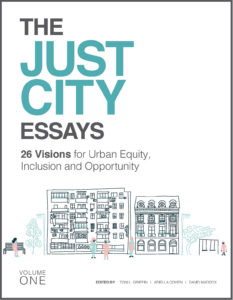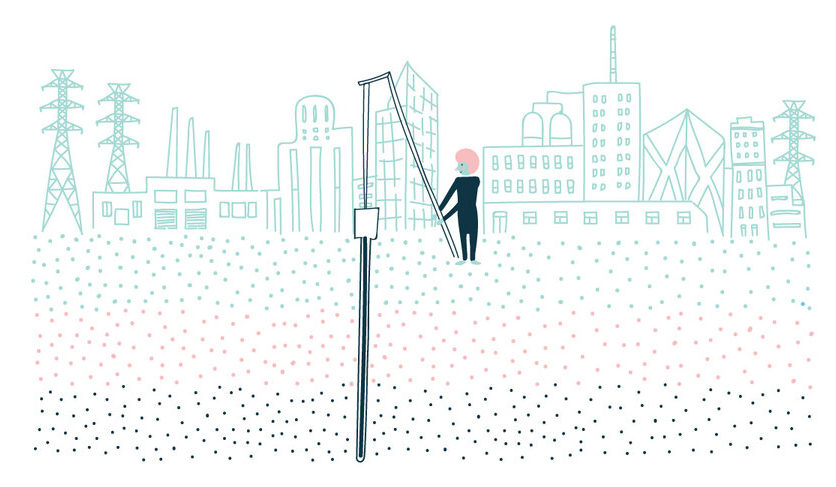“Five years ago, the Harvard Graduate School of Design’s Just City Lab published The Just City Essays: 26 Visions of Inclusion, Equity and Opportunity. The questions it posed were deceptively simple: What would a just city look like? And what could be the strategies to get there? These questions were posed to mayors, architects, artists, philanthropists, educators and journalists in 22 cities, who told stories of global injustice and their dreams for reparative and restorative justice in the city.
 These essays were meant as a provocation, a call to action. Now, during these times of dissonance, unrest, and uncertainty, their contents have become ever more important. For the next 26 weeks [starting June 15, 2020], the GSD and the Just City Lab will republish one essay a week here and at designforthejustcity.org. We hope they may continue conversations of our shared responsibility for the just city.
These essays were meant as a provocation, a call to action. Now, during these times of dissonance, unrest, and uncertainty, their contents have become ever more important. For the next 26 weeks [starting June 15, 2020], the GSD and the Just City Lab will republish one essay a week here and at designforthejustcity.org. We hope they may continue conversations of our shared responsibility for the just city.
We believe design can repair injustice. We believe design must restore justice, especially that produced by its own hand. We believe in justice for Black Americans. We believe in justice for all marginalized people. We believe in a Just City.”
—Toni L. Griffin, Professor in Practice of Urban Planning, founder of the Just City Lab, and editor of The Just City Essays
Justice from the Ground Up
By Julie Bargmann
Soil contamination is a baseline condition for most of the sites I’ve worked on over the past two decades. The toxic imprint derives from industry—steel production, shipbuilding, fabrication of automobile and machine parts, to name just a few—in both urban and rural settings. But it also comes from lead-containing gasoline and paint, banned long ago but still quietly wreaking havoc. It’s a byproduct of the human pursuit of greater material wealth and a more convenient and comfortable life. In other words, it’s the legacy of progress, for better or worse.
As a landscape designer with expertise in toxic remediation and the regeneration of fallow land, the “better or worse” part is vitally important to me. I can say that with certainty, thanks to hindsight and 30 years of academic and professional experience. I didn’t grow up with the term “environmental justice,” which came into use in the 1980s to describe, in part, the unequal distribution of the benefits and burdens of progress. But I now know what a growing body of research shows: in the United States there’s a disturbing overlap between the maps showing where poor people and ethnic minorities live, and where contaminated soils exist.
You might use a stronger word than “disturbing” if you or a loved one were to develop a learning disability, cancer, or liver damage, which are just three of the many proven ill-effects of poisoning by lead, arsenic, and other pernicious elements found in soil. As I write this essay, residents of Vernon, California, in East Los Angeles, a low-income and largely Latino community, were celebrating a bittersweet victory, after forcing the closure of a battery recycling plant owned by New Jersey–based Exide Technologies. The sickening part of the story, pun intended, is that the plant operated for two decades after its environmental violations were first reported to the California Department of Toxic Substances Control (DTSC). Both the cleanup efforts (just 150 of 10,000 contaminated properties were reported to have undergone soil remediation as of early October) and the official response have been weak. “All of us could have acted sooner to develop a more complete picture of what the operations of that facility meant to the health of the residents around it,” DTSC director Barbara A. Lee said. She hastened to add that “the department had tried to shut down the facility in the past but the courts blocked the effort,” according to one published report.
When I read that I chuckled sadly to myself. It reminded me of an exchange I had a few years ago with a high-ranking city official with oversight of a new development for low-income residents I was working on. The developers were eager to start construction, to show “progress,” so they broke ground before testing the soil. Sure enough, the dirt was hot. I had joined the project late, when the momentum to build the inaugural prototype house was unstoppable. But when I learned the test results, remediation was still possible, and regardless, I was bound to report them. I still get a pit in my stomach when I think of the official’s response, which went something like this: The city has enough problems that are plain to see, so let’s not add to them by disclosing a difficult truth, especially one that’s invisible. To my disappointment, the project team elected not to address the contamination, and I was politely excused from the job. Continue reading on designforthejustcity.org…
